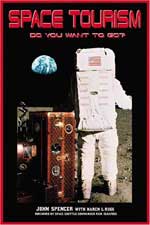
Given the chance, most people would be off vacationing in space at a moment’s notice. Spencer’s plan is to make the holiday a lot more enjoyable than a weekend spent bouncing about Mir’s functional but restrictive interior. He has visions of space yachts in races similar to the America’s Cup; sentinel robots with self aware artificial intelligence maintain the yacht and keep the passengers happy; lunar dune buggies provide for excursions outside the yacht, much like excursions for cruise ships; and simulation centres on Earth train and condition people to their out-of-this-world holiday. With all this at hand, space vacationing would be very popular.
And popularity is a key condition for Spencer. He expects more than 800 people per month will be vacationing, once the infrastructure is in space. For example, a significant portion of the text describes the design of his own yacht, the Destiny. This yacht allows for a small group of passengers to mingle or enjoy solitary relaxation. Rooms, suites and common areas are created by self inflating structures. Environments are conditioned by service robots running on batteries. Safety is ensured by the afore mentioned AI sentinel. Self inflating space ports provide ‘harbours’ for the Destiny and her sister ships. There are even descriptions of coastguard like vessels that ensure the safety of the space lanes. All this is to allow the very rich to enjoy the Earth’s luxuries (wine, dining and dancing) while in the nouvelle regions of space. With this emphasis on pleasure, there should be no challenge meeting the monthly quota.
Though Spencer’s image of space tourism is wonderful, his tie-ins to the practicalities is not. He expects space tourism to be well established by the year 2050, in spite of today’s obvious challenges of building and maintaining the International Space Station. Because of this, his book reads a little too much like science fiction. Almost every aspect of his infrastructure requires large leaps in current scientific and engineering knowledge. For example, his space vessel windows will have material that, on verbal command, changes to allow different sun/radiation intensities into the cabin. This would be more believable if there were an estimate of the effort to get to the required state. Another example is that his vessels include a squad of specialized robots. However, there are no trade off assessments made between the cost and effectiveness of robots to people. Perhaps most telling is his reliance on a low cost orbital access vehicle for which we’re all waiting. In consequence when regarding practicalities, the book is much more of a marketing flyer than it is a business plan.
I think that to get the most out of this book, you must set aside the practical and pessimistic side of your mind and let your free thinking self take over. A particularly rewarding is a first hand account of a lottery winner taking a space holiday in the future. This person starts with describing their training and conditioning through simulation centres on Earth. Next are meetings with fellow passengers at the launch area, safety drills, and the launch to an orbiting port. From there, the winner heads into the space yacht and spends a few luxurious days watching the Earth spin beneath them and the stars twinkle all about. Onboard and off board, activities keep everyone happy and entertained. Upon completion and debarkation, the lottery winner becomes an outspoken advocate for space tourism. In summary, this chapter is the most entertaining and the highlight of the text.
In conclusion, the supposition of the authors is that, today, there is a valid space tourism movement that can lead to a real industry in the near future. The people of this movement believe that by continually highlighting the potential benefits and applauding any steps made in this direction, they will have eventual success. Dennis Tito’s self-paid trip is the landmark they often cite. Also, one complete chapter is dedicated to the progress in space tourism from the mid-1960’s to now. Though this chapter appears to be the summary of the author’s day timer or diary, it still is an interesting and unique view into the progression of space tourism movement from a nascent bottom feeder to today being an oft seen marketing tool and front page head liner. Perhaps, the subtitle would have been more accurate as, ‘do you want to tour in space, then jump on the band wagon!’.
Space tourism, to some people, will be the final industry to succeed in the thrust to the stars. John Spencer and Karen Rugg in their book Space Tourism – Do You Want to Go? show how space tourism can lead the way. They present plans and ideas to build upon the existing space tourism movement so that a full fledged bit of fun can happen in space. Just think what your longest drive might be during a friendly golf game on the moon!
To get your own copy, visit Countdown Creations.
Review by Mark Mortimer
